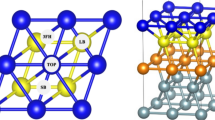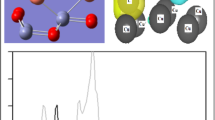Abstract
Using density functional theory methods, H2O dissociation was investigated on the Ni(111), Ni(100), and Ni(110) surfaces. H and O atom as well as OH species adsorb stably at the high coordination sites. While on the Ni(110) surface, the OH species prefers at the twofold short bridge site because the adsorption on the fourfold hollow site is less feasible due to the increased distances between the nickel atoms. The amount of charge transfer is related to the adsorption stability. The more charge transfer, the more stable the adsorption. The charge transfer decreases in the order of O > OH > H. H2O molecule adsorbs at the top site in a configuration parallel to the surface. The final products are different for H2O dissociation due to the different mechanisms. On the Ni(111) surface, the final product is the O atom. On the Ni(100) and Ni(110) surfaces, the most abundant species are OH and H, but the reaction mechanisms were different. It is not necessary to linear BEP relationship for a given reaction on different surfaces. These results could provide fundamental insights into water behaviors and a favorable theoretical basis for further understanding and research on the interaction between water and metal surfaces.
Graphical Abstract







Similar content being viewed by others
Data availability
The manuscript has full control of all primary data, and the authors agree to allow the journal to review their data if requested.
References
Hodgson A, Haq S (2009). Surf Sci Rep 64:381–451
Roy S, Nayanthara KJ, Tiwari N, Tiwari AK (2020). Int Rev Phys Chem 39:267–318
Wang G, Tao S, Bu X (2006). J Catal 224:10–16
Benndorf C, Nöbl C, Rusenberg M, Thieme F (1981). Surf Sci 111:87–101
Benndorf C, Nöbl C, Thieme F (1982). Surf Sci 121:249–259
Peebles DE, White JM (1984). Surf Sci 144:512–540
Jacobi K, Rotermund HH (1983). Surf Sci 133:401–421
Siepmann JI, Sprik M (1992). Surf Sci 279:185–190
Pangher N, Schmalz A, Haase J (1994). Chem Phys Lett 221:189–193
Callen BW, Griffiths K, Memmert U, Harrington DA, Bushby SJ, Norton PR (1990). Surf Sci 230:159–174
Callen BW, Griffiths K, Kasza RV, Jensen MB, Thiel PA, Norton PR (1992). J Chem Phys 97:3760–3774
Pirug G, Knauff O, Bonzel HP (1994). Surf Sci 321:58–70
Benndorf C, Madey TE (1988). Surf Sci 194:63–91
Roy S, Nayanthara KJ, Tiwari AK (2019). J Indian Chem Soc 96:883–893
Nakamura M, Ito M (2004). Chem Phys Lett 384:256–261
Pozzo M, Carlini G, Rosei R, Alfè D (2007). J Chem Phys 126:164706
Catapan RC, Oliveira AAM, Chen Y, Vlachos DG (2012). J Phys Chem C 116:20281–20291
Hariharan S, Tiwari AK (2013). J Chem Phys 139:174707
Murakhtina T, Delle Site L, Sebastiani D (2006). Chem Phys Chem 7:1215–1219
Kresse G, Furthmüller J (1996). Comput Mater Sci 6:15–50
Kresse G, Furthmüller J (1996). Phys Rev B Condens Matter 54:11169–11186
Perdew JP, Burke K, Ernzerhof M (1996). Phys Rev Lett 77:3865–3868
Henkelman G, Uberuaga BP, Jónsson H (2000). J Chem Phys 113:9901–9904
Monkhorst HJ, Pack JD (1976). Phys Rev B 13:5188–5192
71CRC (2013) In: Haynes WM (ed) Handbook of Chemistry and Physics. CRC Press, New York
Liu T, Chen J, Zhang Z, Shen X, Fu B, Zhang DH (2018). J Chem Phys 148:144705
Liu SL, Tian XX, Wang T, Wen XD, Li YW, Wang JG, Jiao H (2014). J Phys Chem C 118:26139–26154
Gao R, Cao DB, Liu SL, Wang J, Li YW, Jiao H (2013). Appl Catal A 468:370–384
Paul JF, Sautet P (1996). Surf Sci 356:1–3
Yang H, Whitten JL (1997). Surf Sci 370:136
Michaelides A, Hu PA (2000). J Chem Phys 112:8120–8125
Kresse G, Hafner J (2000). Surf Sci 459:0–302
Greeley J, Mavrikakis M (2017). J Phys Chem B 109:3460
Hariharan S, Tiwari AK (2014). J Chem Phys 140:174704
Gan L, Tian R, Yang X, Lu H, Zhao Y (2012). J Phys Chem C 116:745–752
Huang Y, Ling C, Jin M, Du J, Zhou T, Wang S (2013). Phys Chem Chem Phys 15:17804–17817
Bronsted JN (1928). Chem Rev 5:231–338
Evans MG, Polanyi M (1938). Trans Faraday Soc 34:11
Liu SL, Li YW, Wang J, Jiao H (2017). Catal Sci Technol 7:427–440
Munter TR, Bligaard T, Christensen CH, Nørskov JK (2008). Phys Chem Chem Phys 10:5202
Liu ZP, Hu P (2001). J Chem Phys 114:8244
Liu ZP, Hu P (2001). J Am Chem Soc 123:12596
Michaelides A, Liu ZP, Zhang CJ, Alavi A, King DA, Hu P (2003). J Am Chem Soc 125:3704
Fajin JLC, Cordeiro MNDS, Gomes JRB (2016). RSC Adv 6:18695–18702
Roy S, Hariharan S, Tiwari AKP (2018). Phys Chem C 122:10857–10870
Wang S, Petzold V, Tripkovic V, Kleis J et al (2011). Phys Chem Chem Phys 13:20760–20765
Ghosh S, Hariharan S, Tiwari AK (2017). J Phys Chem C 121:16351–16365
Funding
This work was supported by the National Natural Science Foundation of China (No. 21803052), and Natural science foundation of Shandong province (No. ZR2018LB017). The grants are gratefully acknowledged.
Author information
Authors and Affiliations
Contributions
Xuejie Hou: formal analysis, investigation, writing original draft; Lingxi Qi: data curation and editing; Wenzuo Li: conceptualization, supervision; Jin Zhao: methodology, visualization; Shaoli Liu: review, editing, and modification.
Corresponding authors
Ethics declarations
Conflict of interest
The authors declare that they have no conflict of interest.
Consent for publication
Obtained the informed consent of all participants.
Code availability
Not applicable
Additional information
Publisher’s note
Springer Nature remains neutral with regard to jurisdictional claims in published maps and institutional affiliations.
Rights and permissions
About this article
Cite this article
Hou, X., Qi, L., Li, W. et al. Theoretical study on water adsorption and dissociation on the nickel surfaces. J Mol Model 27, 36 (2021). https://doi.org/10.1007/s00894-020-04662-4
Received:
Accepted:
Published:
DOI: https://doi.org/10.1007/s00894-020-04662-4




